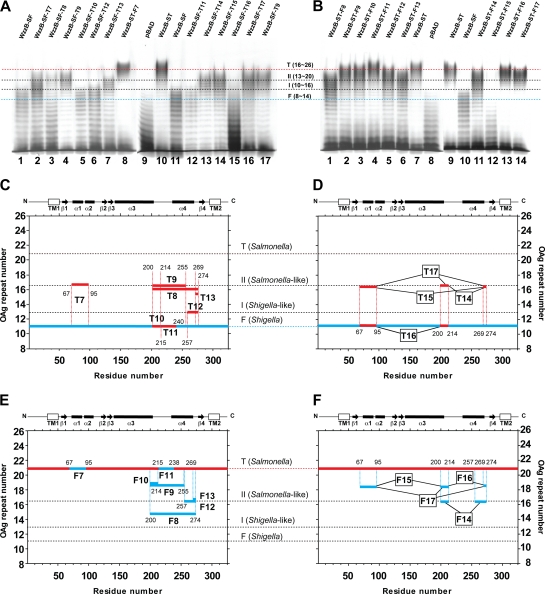Fig. 5.
Effect of reciprocal single- and multiple-domain swapping of small regions of WzzB from S. flexneri and S. Typhimurium. (A) silver-stained polyacrylamide gel showing the O-antigen LPS profile of E. coli EVV33 (pMF19) expressing different forms of WzzB (Table 1). The designations T7 to T13 indicate that the chimera contains one segment from WzzBST in the WzzBSF background, while T14 to T17 denote two or more segments of WzzBST in the WzzBSF background. The designations F7 to F13 indicate that the chimera contains one segment from WzzBSF in the WzzBST background. F14 to F17 denotes two or more segments of WzzBSF in the WzzBST background. Lanes 1 and 11, parental WzzBSF; lane 2, WzzBSFV67-L95>A67-F95WzzBST (WzzB-SF-T7); lane 3, WzzBSFQ202-I274>E202-V274WzzBST (WzzB-SF-T8); lanes 4 and 17, WzzBSFQ202-A253>E202-N253WzzBST (WzzB-SF-T9); lane 5, WzzBSFQ202-K214>E202-Q214WzzBST (WzzB-SF-T10); lane 6, WzzBSFN260-I274>T260-V274WzzBST (WzzB-SF-T12); lane 7, WzzBSFF269-I274>V269-V274WzzBST (WzzB-SF-T13); lane 8, WzzBSTA67-F95>V67-L95WzzBSF (WzzB-ST-F7); lane 9, pBAD vector control; lane 10, parental WzzBST; lane 12, WzzBSFV217-E237>I217-K237WzzBST (WzzB-SF-T11); lane 13, WzzBSFQ202-K214>E202-Q214/F269-I274>V269-V274WzzBST (WzzB-SF-T14); lane 14, WzzBSFV67-L95>A67:F95/F269-I274>V269-V274 WzzBST (WzzB-SF-T15); lane 15, WzzBSFV67-L95>A67-F95/Q202-K214>E202-Q214WzzBST (WzzB-SF-T16); and lane 16, WzzBSFV67-L95>A67:F95/Q202-K214>E202-Q214/F269-I274>V269-V274WzzBST (WzzB-SF-T17). (B) Silver-stained polyacrylamide gel showing the O-antigen LPS profile of E. coli EVV33 (pMF19) expressing various recombinant WzzB forms (Table 1). Lane 1, WzzBSTE202-V274>Q202-I274WzzBSF (WzzB-ST-F8); lane 2, WzzBSTE202-N253>Q202-A253 WzzBSF (WzzB-ST-F9); lane 3, WzzBSTE202-Q214>Q202-K214WzzBSF (WzzB-ST-F10); lane 4, WzzBSTI217-K237>I217-E237WzzBSF (WzzB-ST-F11); lane 5, WzzBSTT260-V274>N260:I274WzzBSF (WzzB-ST-F12); lane 6, WzzBSTV269-V274>F269-I274WzzBSF (WzzB-ST-F13); lanes 7 and 9, parental WzzBST; lane 8, pBAD vector control; lane 10, parental WzzBSF; 11, WzzBSTE202-Q214>Q202-K214/T260-V274>N260-I274WzzBSF (WzzB-ST-F14); lane 12, WzzBSTA67-F95>V67-I95/E202-Q214>Q202-K214WzzBSF (WzzB-ST-F15); lane 13, WzzBSTE202-Q214>Q202-K214/V269-V274>F269-I274WzzBSF (WzzB-ST-F16); and lane 14, WzzBSTA67-F95>V67-I95/V269-V274>F269-I274WzzBSF (WzzB-ST-F17. Dotted lines indicate the average modality for the E. coli K-12 (O16) LPS OAg molecules, as determined by WzzBST (T), WzzBST-like (II), WzzBSF-like (I), and WzzBSF (F) proteins. (C and D) Graphical representation of the changes in modality observed for hybrids in panel A, lanes 2 to 7 and 12 as well as lanes 13 to 16, respectively. (E and F) Graphical representation of the changes in modality observed for hybrids in panels A (lane 8) and B (lanes 1 to 6) as well as in panel B, lanes 11 to 14, respectively. Hybrid polypeptides are plotted according to the residue number (on the x axis) and the average modality (OAg repeat number; on the y axis). Thick red segments indicate the regions derived from WzzBST, while thick blue segments indicate WzzBSF regions. A linear representation of the structural map of WzzB and the location of the hybrid endpoints are also indicated in panels C through F.

